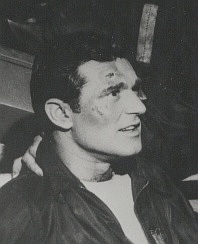People Are Alike All Over
This article includes a list of general references, but it lacks sufficient corresponding inline citations. (August 2010) |
| "People Are Alike All Over" | |
|---|---|
| The Twilight Zone episode | |
 Paul Comi as Marcusson | |
| Episode no. | Season 1 Episode 25 |
| Directed by | Mitchell Leisen |
| Teleplay by | Rod Serling |
| Based on | "Brothers Beyond the Void" by Paul W. Fairman |
| Production code | 173-3613 |
| Original air date | March 25, 1960 |
| Guest appearances | |
| |
"People Are Alike All Over" is episode 25 of the
Opening narration
You're looking at a species of flimsy little two-legged animal with extremely small heads, whose name is Man. Warren Marcusson, age thirty-five. Samuel A. Conrad, age thirty-one. They're taking a highway into space, Man unshackling himself and sending his tiny, groping fingers up into the unknown. Their destination is Mars, and in just a moment we'll land there with them.
Plot
Two
Now alone, Conrad hears a
Conrad relaxes, but soon discovers that his room is windowless and the doors cannot be opened. One of the walls slides apart, and Conrad realizes that he has become a caged exhibit in a Martian alien zoo. Conrad picks up a sign saying EARTH CREATURE IN HIS NATIVE HABITAT, and throws it on the floor as Teenya leaves distraught.
In the episode's closing lines, Conrad grips the bars and proclaims, "Marcusson! Marcusson, you were right! You were right. People are alike... people are alike everywhere."
Closing narration
Species of animal brought back alive. Interesting similarity in physical characteristics to human beings in head, trunk, arms, legs, hands, feet. Very tiny undeveloped brain. Comes from primitive planet named Earth. Calls himself Samuel Conrad. And he will remain here in his cage with the running water and the electricity and the central heat as long as he lives. Samuel Conrad has found The Twilight Zone.
Production notes
This episode was based on Paul W. Fairman's "Brothers Beyond the Void", published in the March 1952 issue of Fantastic Adventures and also included in August Derleth's 1953 anthology collection Worlds of Tomorrow. In this renowned short story, Sam Conrad remains on Earth and it is the lone pilot Marcusson who has the too-close encounter with smaller, more alien Martians. In adapting the tale, Serling made key changes that would deepen the irony and heighten the impact. He installed the apprehensive, defeatist Conrad as the protagonist, easing his fears, only to have them ultimately confirmed; and he presented the Martians as a human-like superior race whose apparent benevolence would make their climactic treachery seem even more shocking, as well as decrease the budget that would have been expended on costumes and makeup.
The
Marcusson is portrayed by
Actor Byron Morrow twice appeared as an admiral on Star Trek. Actor Vic Perrin was later the "Control Voice" of The Outer Limits, and—like Oliver, Morrow and Comi—would also become another veteran of Star Trek.
Themes
Cat Yampell, comparing the show to other science fiction stories such as Planet of the Apes (also starring Roddy McDowall) and Slaughterhouse-Five, wrote: "Alien caging of humans provides commentary on the barbarity of the practice of turning sentient beings into public spectacles."[1]
Influence
The original
The band Space Monkey Death Sequence released their similarly titled debut album, "People Are Alike All Over", containing many samples from the episodes, citing the installment as the influence for the album.[2]
The second episode of the television series The Orville, which is titled Command Performance, revolves around the two main characters, Captain Ed Mercer and Commander Kelly Grayson, being placed in a zoo along with other captured alien species.
See also
Further reading
- DeVoe, Bill. (2008). Trivia from The Twilight Zone. Albany, GA: Bear Manor Media. ISBN 978-1-59393-136-0
- Grams, Martin. (2008). The Twilight Zone: Unlocking the Door to a Television Classic. Churchville, MD: OTR Publishing. ISBN 978-0-9703310-9-0
References
External links
- "People Are Alike All Over" at IMDb
